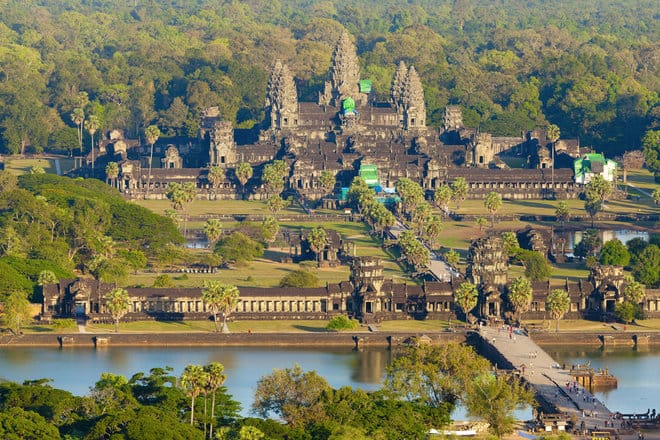Designated a UNESCO World Heritage Site in 1992, the TEMPLES OF ANGKOR are scattered over some four hundred square kilometres of countryside between the Tonle Sap lake and the Kulen Mountains, although the most famous are clustered close to Siem Reap, 310km northwest of Phnom Penh. Atmospherically surrounded by patches of dense forest and standing proudly above rice paddies, the temples do not feel like sterile museum pieces, but seem still to be part of everyday life – aspects of which continue much as depicted in temple bas-reliefs.
For most visitors, Angkor Wat, an iconic temple of soaring towers and intricate carvings just a short drive from Siem Reap, is the chief reason to visit Cambodia. The first glimpse of its breathtaking sanctuaries lingers in the memory forever, while its gallery of bas-reliefs – exceptional in both detail and quality of execution – is a delight for novices and experts alike. Running it a close second is the nearby walled city of Angkor Thom, its gateways famously topped with four huge stone faces. The motif is continued at the very centre of Angkor Thom in the Bayon, Jayavarman VII’s state-temple, which has two galleries of bas-reliefs.

There’s much more to Angkor than just these main sights, however. The site is vast, covering an area of some four hundred square kilometres, and diverse, with buildings ranging in scale from early, tiny brick towers like Prasat Kravan to the massive and stark sandstone edifice of Ta Keo. You could easily spend two full weeks at Angkor and still have more to see, but most people find three days is enough to take in the principal sites, albeit in a bit of a rush; four to five days is better. Many of the most important temple sites are within a few minutes’ drive of Siem Reap, but a few are scattered much further afield; transport is easily hired in Siem Reap and access roads are now in decent condition.
The government’s active promotion of Angkor Wat as a tourist destination has seen visitor figures soar, turning the once sleepy Siem Reap into a tourist hot spot. The local airport is linked with a number of Asian cities as well as Phnom Penh; National Route 6 south to the capital and north to Thailand is in excellent condition; and boats from Phnom Penh and Battambang remain popular with tourists. Surprisingly, given the explosion of new hotels, restaurants and bars, Siem Reap retains its small-town atmosphere.

If you tire of temples, the floating villages of Tonle Sap, the massive freshwater lake that dominates central Cambodia, are worth exploring. The land south of Siem Reap is part of the lake’s flood plain, and is inundated from June to November. North of town, the rice fields stretch out to the natural boundary formed by the Kulen Mountains which divide the lush lowland from the province’s more barren north; here, at Phnom Kulen is Cambodia’s largest reclining Buddha, carved out of a massive rock, while at two spots on the Siem Reap River (which rises in these mountains and flows south to drain into the great lake) the river bed itself has been carved with intricate linga and religious scenes. The far north of the province is worth visiting only if you are curious to see Anlong Veng, the site of Pol Pot’s death.
Brief history
For six hundred years the area around the provincial town of Siem Reap, was the heart of the Khmer Empire. Its rise to importance began in 802 with Jayavarman II’s move to Phnom Kulen and ended when the Thais sacked Angkor Thom in 1431. A ready supply of water and the fertility of the land meant that the area could support large populations, and successive Angkorian kings constructed their royal cities and state-temples here. The empire reached its apogee in the twelfth century under the leadership of Jayavarman VII – the greatest temple-builder of all – when it stretched from the coast of Vietnam to the Malay peninsula, to Pagan in Burma and north to Laos. However, once abandoned, this part of Cambodia sank into obscurity until, at the end of the eighteenth century, as part of Battambang province, it came under Thai rule, a state of affairs that lasted until 1907, when the French negotiated its return.
Angkor’s earliest monuments date from 802, when Jayavarman II came north from Kompong Cham to set up court at Phnom Kulen. No further stone temples were built after the reign of Jayavarman VII, the greatest temple-builder of them all, came to an end in 1219; scholars theorize that either the area’s resources were exhausted or the switch to Theravada Buddhism may have precluded their construction. After Jayavarman VII, the temples and palaces remained in use until they were sacked by the Thais in 1431; the following year, Ponhea Yat took his court south to Phnom Penh and left Angkor to the jungle. Though Angkor was never completely deserted, the local people who continued to worship at the temples were unable to maintain them.
Around 1570, King Satha was so enchanted when he rediscovered Angkor Thom deep in the jungle that he had the undergrowth cleared and brought his court there, though by 1594 he was back at Lovek. Another short-lived period of royal interest occurred in the middle of the seventeenth century when, according to a letter penned by a Dutch merchant to the governor-general of the Dutch East Indies, “the king [Barom Rachea VI] paid a visit to a lovely pleasant place known as Anckoor”. Subsequently, despite tales of a lost city in the Cambodian jungle filtering back to the West via missionaries and traders, it wasn’t until the nineteenth C century that Cambodia opened up to European explorers.
The first proper account of Angkor Wat, published by the French missionary Charles-Emile Bouillevaux in 1858, failed to arouse wide interest, but in 1864, the diaries of botanist and explorer Henri Mouhot, who had stumbled on Angkor by accident a few years earlier, were published posthumously, and the temples gripped the world. The Briton J. Thompson published the first photographs of Angkor in 1867, and was the first to suggest a link between temple architecture and the mythical Mount Meru. Close behind him came Doudart Lagrée, who discovered Beng Mealea and Preah Khan (Kompong Thom).






